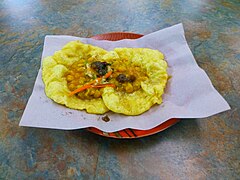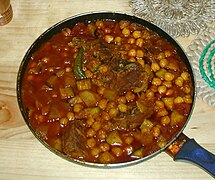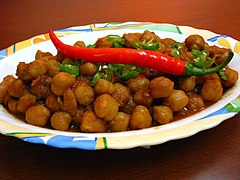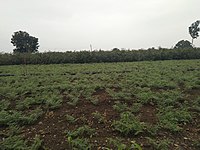Chickpea
| Chickpeas | |
|---|---|
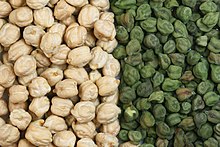
| |
| Dried chickpeas. The larger light tan kabuli and variously coloured desi are the two main types of chickpea. They are green when picked early and vary through tan or beige, speckled, dark brown to black. Seventy-five percent of world production is of the smaller desi type. | |

| |
| Sprouted chickpea | |
| Scientific classification | |
| Kingdom: | Plantae |
| Clade: | Tracheophytes |
| Clade: | Angiosperms |
| Clade: | Eudicots |
| Clade: | Rosids |
| Order: | Fabales |
| Family: | Fabaceae |
| Subfamily: | Faboideae |
| Genus: | Cicer |
| Species: | C. arietinum
|
| Binomial name | |
| Cicer arietinum | |
| Synonyms[1] | |
| |

The chickpea or chick pea (Cicer arietinum) is an annual legume of the family Fabaceae, subfamily Faboideae.[2][3] Its different types are variously known as gram[4][5] or Bengal gram,[5] chhola, chhana, chana, or channa, garbanzo[5] or garbanzo bean, or Egyptian pea.[4] Chickpea seeds are high in protein. It is one of the earliest cultivated legumes, the oldest archaeological evidence of which was found in Syria.[6][7][8]
The chickpea is a key ingredient in Mediterranean and Middle Eastern cuisines, used in hummus, and, when soaked and coarsely ground with herbs and spices then made into patties and fried, falafel. As an important part of Indian cuisine, it is used in salads, soups and stews, and curry, in chana masala, and in other food products that contain channa (chickpeas). In 2022, India accounted for 75% of global chickpea production.[9]
Etymology[edit]
The name "chickpea", earlier "chiche pease", is modelled on Middle French pois chiche, where chiche comes from Latin cicer. "Chich" was used by itself in English from the 14th to the 18th centuries.[10] The word garbanzo, from an alteration of Old Spanish arvanço, came first to English as "garvance" in the 17th century, being gradually anglicized to "calavance", though that came to refer to a variety of other beans, including the hyacinth bean. The current form garbanzo comes directly from modern Spanish.[11]
History[edit]
The earliest well-preserved archaeobotanical evidence of chickpea outside its wild progenitor's natural distribution area comes from the site of Tell el-Kerkh, in modern Syria, dating back to the early Pre-Pottery Neolithic period around c.8400 BC.[12]
Cicer reticulatum is the wild progenitor of chickpeas. This species currently grows only in southeast Turkey, where it is believed to have been domesticated. The domestication event can be dated to around 7000 BC. Domesticated chickpeas have been found at Pre-Pottery Neolithic B sites in Turkey and the Levant, namely at Çayönü, Hacilar, and Tell es-Sultan (Jericho).[13] Chickpeas then spread to the Mediterranean region around 6000 BC and India around 3000 BC.[13]
In southern France, mesolithic layers in a cave at L'Abeurador, Hérault, have yielded chickpeas, carbon-dated to 6790±90 BC.[14] They were found in the late Neolithic (about 3500 BC) sites at Thessaly, Kastanas, Lerna and Dimini, Greece.
Chickpeas are mentioned in Charlemagne's Capitulare de villis (about 800 AD) as cicer italicum, as grown in each imperial demesne. Albertus Magnus mentions red, white, and black varieties. The 17th-century botanist Nicholas Culpeper noted "chick-pease or cicers" are less "windy" than peas and more nourishing. Ancient people also associated chickpeas with Venus because they were said to offer medical uses such as increasing semen and milk production, inducing menstruation and urination, and helping to treat kidney stones.[15] "White cicers" were thought to be especially strong and helpful.[15]
In 1793, ground, roasted chickpeas were noted by a German writer as a substitute for coffee in Europe.[16] In the First World War, they were grown for this use in some areas of Germany.[17] They are still sometimes brewed instead of coffee.[16]
Genome sequencing[edit]
Sequencing of the genome of the chickpea has been completed for 90 chickpea genotypes, including several wild species.[18] A collaboration of 20 research organizations, led by the International Crops Research Institute for the Semi-Arid Tropics (ICRISAT), sequenced CDC Frontier, a kabuli chickpea variety, and identified more than 28,000 genes and several million genetic markers.[19]
Description[edit]
This section needs additional citations for verification. (June 2021) |

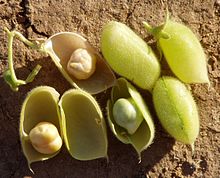
The plant grows to 20–50 cm (8–20 in) high and has small, feathery leaves on either side of the stem. Chickpeas are a type of pulse, with one seedpod containing two or three peas. It has white flowers with blue, violet, or pink veins.
Varieties[edit]
The most common variety of chickpea in South Asia, Ethiopia, Mexico, and Iran is the desi type, also called Bengal gram.[20] It has small, dark seeds and a rough coat. It can be black, green or speckled. In Hindi, it is called desi chana 'native chickpea' or kala chana 'black chickpea', and in Assamese, it is called boot or chholaa boot. It can be hulled and split to make chana dal, Kurukshetra Prasadam (channa laddu),[21] and bootor daali.
Around the Mediterranean and in the Middle East, the most common variety of chickpea is the kabuli type. It is large and tan-colored, with a smooth coat. It was introduced to India in the 18th century from Afghanistan and is called kabuli chana in Hindi.[22]
An uncommon black chickpea, ceci neri, is grown only in Apulia and Basilicata, in southern Italy. It is around the same size as garbanzo beans, larger and darker than the 'desi' variety.
Uses[edit]
This section needs additional citations for verification. (June 2021) |
Culinary[edit]

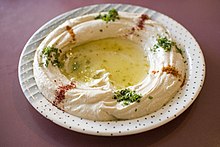

Chickpeas are usually rapidly boiled for 10 minutes and then simmered for longer. Dried chickpeas need a long cooking time (1–2 hours) but will easily fall apart when cooked longer. If soaked for 12–24 hours before use, cooking time can be shortened by around 30 minutes. Chickpeas can also be pressure cooked or sous vide cooked at 90 °C (194 °F).
Mature chickpeas can be cooked and eaten cold in salads, cooked in stews, ground into flour, ground and shaped in balls and fried as falafel, made into a batter and baked to make farinata or socca, or fried to make panelle. Chickpea flour is known as gram flour or besan in South Asia and is used frequently in South Asian cuisine.
In Portugal, chickpeas are one of the main ingredients in rancho, eaten with pasta, meat, or rice. They are used in other hot dishes with bacalhau and in soups, meat stews, salads mixed with tuna and vegetables, olive oil, vinegar, hot pepper and salt. In Spain, they are used cold in tapas and salads, as well as in cocido madrileño.
Hummus is the Arabic word for chickpeas, which are often cooked and ground into a paste and mixed with tahini (sesame seed paste) to make ḥummuṣ bi ṭaḥīna, usually called simply hummus in English. By the end of the 20th century, hummus had become common in American cuisine:[23] by 2010, 5% of Americans consumed it regularly,[23] and it was present at some point in 17% of American households.[24]
In the Middle East, chickpeas are also roasted, spiced, and eaten as a snack, such as leblebi.
Chickpeas and Bengal grams are used to make curries.[25] They are one of the most popular vegetarian foods in the Indian subcontinent[26] and in diaspora communities of many other countries, served with a variety of bread or steamed rice. Popular dishes in Indian cuisine are made with chickpea flour, such as mirchi bajji and mirapakaya bajji.[27] In India, as well as in the Levant, unripe chickpeas are often picked out of the pod and eaten as a raw snack, and the leaves are eaten as a leaf vegetable in salads. In India, desserts such as besan halwa[28] and sweets such as mysore pak, and laddu are made.
Chickpea flour is used to make "Burmese tofu", which was first known among the Shan people of Burma. In South Asian cuisine, chickpea flour (besan) is used as a batter to coat vegetables before deep frying to make pakoras. The flour is also used as a batter to coat vegetables and meats before frying or fried alone, such as panelle (little bread), a chickpea fritter from Sicily. Chickpea flour is used to make the Mediterranean flatbread socca and is called panisse in Provence, southern France. It is made of cooked chickpea flour, poured into saucers, allowed to set, cut into strips, and fried in olive oil, often eaten during Lent. In Tuscany, chickpea flour (farina di ceci) is used to make an oven-baked pancake: the flour is mixed with water, oil and salt. Chickpea flour, known as kadlehittu in Kannada, is used for making sweet dish Mysore pak.
In the Philippines, chickpeas preserved in syrup are eaten as sweets and in desserts such as halo-halo.
Ashkenazi Jews traditionally serve whole chickpeas, referred to as arbes (אַרבעס) in Yiddish, at the Shalom Zachar celebration for baby boys. The chickpeas are boiled until soft and served hot with salt and lots of ground black pepper.[29]
Guasanas or garbanza is a Mexican chickpea street snack. The beans, while still green, are cooked in water and salt, kept in a steamer to maintain their humidity, and served in a plastic bag.
A chickpea-derived liquid (aquafaba) can be used as an egg white replacement to make meringue[30] or ice cream, with the residual pomace used as flour.[31]
-
Doubles, a street food in Trinidad and Tobago
-
Manchego cuisine; chickpea and Silene vulgaris stew (potaje de garbanzos y collejas)
-
Farinata di ceci, a traditional Italian chickpea snack food
-
Chakhchoukha in Algerian cuisine; freshly cooked marqa before mixing with rougag
-
Chana masala, India
-
Halua chickpeas, Bangladesh
-
Fried chickpea
Animal feed[edit]
Chickpeas are an energy and protein source as animal feed.[32]
Raw chickpeas have a lower trypsin and chymotrypsin inhibitor content than peas, common beans, and soybeans. This leads to higher nutrition values and fewer digestive problems in nonruminants. Nonruminant diets can be completed with 200 g/kg of raw chickpeas to promote egg production and growth of birds and pigs. Higher amounts can be used when chickpeas are treated with heat.[32]
Experiments have shown that ruminants grow equally well and produce an equal amount and quality of milk when soybean or cereal meals are replaced with chickpeas. Pigs show the same performance, but growing pigs experience a negative effect of raw chickpea feed; extruded chickpeas can increase performance even in growing pigs. Only young broilers (starting period) showed worse performance in poultry diet experiments with untreated chickpeas. Fish performed equally well when extruded chickpeas replaced their soybean or cereal diet.[32] Chickpea seeds have also been used in rabbit diets.[20]
| Country | Production (millions of tonnes) |
|---|---|
| 13.5 | |
| 0.6 | |
| 0.5 | |
| 0.5 | |
| 0.4 | |
| 0.3 | |
| World | 18.1 |
| Source: FAOSTAT of the United Nations[9] | |
Secondary components of legumes—such as lecithin, polyphenols, oligosaccharides; and amylase, protease, trypsin and chymotrypsin inhibitors—can lead to lower nutrient availability, and thus to impaired growth and health of animals (especially in nonruminants). Ruminants generally have less trouble digesting legumes with secondary components since they can inactivate them in the rumen liquor. Their diets can be supplemented by 300 g/kg or more raw chickpea seeds.[32] However, protein digestibility and energy availability can be improved through treatments such as germination, dehulling, and heat. Extrusion is a very good heat technique to destroy secondary legume components since the proteins are irreversibly denatured. Overprocessing may decrease the nutritional value; extrusion leads to losses in minerals and vitamins, while dry heating does not change the chemical composition.[32]
Production[edit]
In 2022, world production of chickpeas was 18 million tonnes, led by India with 75% of the global total (table).[9]
Nutrition[edit]
| Nutritional value per 100 g (3.5 oz) | |
|---|---|
| Energy | 686 kJ (164 kcal) |
27.42 g | |
| Sugars | 4.8 g |
| Dietary fibre | 7.6 g |
2.59 g | |
| Saturated | 0.27 g |
| Monounsaturated | 0.58 g |
| Polyunsaturated | 1.16 g |
8.86 g | |
| Vitamins | Quantity %DV† |
| Vitamin A equiv. | 0% 1 μg |
| Thiamine (B1) | 10% 0.12 mg |
| Riboflavin (B2) | 5% 0.06 mg |
| Niacin (B3) | 3% 0.53 mg |
| Pantothenic acid (B5) | 6% 0.29 mg |
| Vitamin B6 | 8% 0.14 mg |
| Folate (B9) | 43% 172 μg |
| Vitamin C | 1% 1.3 mg |
| Vitamin E | 2% 0.35 mg |
| Vitamin K | 3% 4 μg |
| Minerals | Quantity %DV† |
| Calcium | 4% 49 mg |
| Iron | 16% 2.89 mg |
| Magnesium | 11% 48 mg |
| Manganese | 45% 1.03 mg |
| Phosphorus | 13% 168 mg |
| Potassium | 10% 291 mg |
| Sodium | 0% 7 mg |
| Zinc | 14% 1.53 mg |
| Other constituents | Quantity |
| Water | 60.21 g |
| †Percentages estimated using US recommendations for adults,[33] except for potassium, which is estimated based on expert recommendation from the National Academies.[34] | |
| Nutritional value per 100 g (3.5 oz) | |
|---|---|
| Energy | 1,581 kJ (378 kcal) |
62.95 g | |
| Sugars | 10.7 g |
| Dietary fibre | 12.2 g |
6.04 g | |
| Saturated | 0.603 |
| Monounsaturated | 1.377 |
| Polyunsaturated | 2.731 |
20.5 g | |
| Vitamins | Quantity %DV† |
| Vitamin A equiv. | 0% 3 μg |
| Thiamine (B1) | 40% 0.477 mg |
| Riboflavin (B2) | 16% 0.212 mg |
| Niacin (B3) | 10% 1.541 mg |
| Pantothenic acid (B5) | 32% 1.588 mg |
| Vitamin B6 | 31% 0.535 mg |
| Folate (B9) | 139% 557 μg |
| Vitamin C | 4% 4 mg |
| Vitamin E | 5% 0.82 mg |
| Vitamin K | 8% 9 μg |
| Minerals | Quantity %DV† |
| Calcium | 4% 57 mg |
| Copper | 73% 0.656 mg |
| Iron | 24% 4.31 mg |
| Magnesium | 19% 79 mg |
| Phosphorus | 20% 252 mg |
| Potassium | 24% 718 mg |
| Sodium | 1% 24 mg |
| Zinc | 25% 2.76 mg |
| Other constituents | Quantity |
| Water | 7.68 g |
| †Percentages estimated using US recommendations for adults,[33] except for potassium, which is estimated based on expert recommendation from the National Academies.[34] | |
Chickpeas are a nutrient-dense food, providing rich content (20% or higher of the Daily Value, DV) of protein, dietary fiber, folate, and certain dietary minerals, such as iron and phosphorus in a 100-gram reference amount (see adjacent nutrition table). Thiamin, vitamin B6, magnesium, and zinc contents are moderate, providing 10–16% of the DV. Compared to reference levels established by the United Nations Food and Agriculture Organization and World Health Organization, proteins in cooked and germinated chickpeas are rich in essential amino acids such as lysine, isoleucine, tryptophan, and total aromatic amino acids.[35]
A 100-gram (3+1⁄2-ounce) reference serving of cooked chickpeas provides 686 kilojoules (164 kilocalories) of food energy. Cooked chickpeas are 60% water, 27% carbohydrates, 9% protein and 3% fat (table).[32] Seventy-five percent of the fat content is unsaturated fatty acids for which linoleic acid comprises 43% of the total fat.[36]
Effects of cooking[edit]
Cooking treatments do not lead to variance in total protein and carbohydrate content.[37][38] Soaking and cooking of dry seeds possibly induces chemical modification of protein-fibre complexes, which leads to an increase in crude fibre content. Thus, cooking can increase protein quality by inactivating or destroying heat-labile antinutritional factors.[37] Cooking also increases protein digestibility, essential amino acid index, and protein efficiency ratio. Although cooking lowers concentrations of amino acids such as tryptophan, lysine, total aromatic, and sulphur-containing amino acids, their contents are still higher than proposed by the FAO/WHO reference.[37] Raffinose and sucrose and other reducing sugars diffuse from the chickpea into the cooking water and this reduces or completely removes these components from the chickpea. Cooking also significantly reduces fat and mineral content. The B vitamins riboflavin, thiamin, niacin, and pyridoxine dissolve into cooking water at differing rates.[37]
Germination[edit]
Germination of chickpeas improves protein digestibility, although at a lower level than cooking. Germination degrades proteins to simple peptides, improving crude protein, nonprotein nitrogen, and crude fibre content. Germination decreases lysine, tryptophan, sulphur and total aromatic amino acids, but most contents are still higher than proposed by the FAO/WHO reference pattern.[37]
Oligosaccharides, such as stachyose and raffinose, are reduced in higher amounts during germination than during cooking. Minerals and B vitamins are retained more effectively during germination than with cooking. Phytic acids are reduced significantly, but trypsin inhibitor, tannin, and saponin reduction is less effective than cooking.[37]
Autoclaving, microwave cooking, boiling[edit]
All treatments of cooking improve protein digestibility.[citation needed] Essential amino acids are slightly increased by boiling and microwave cooking compared to autoclaving and germination. Overall, microwave cooking leads to a significantly lower loss of nutrients than autoclaving and boiling.[citation needed][disputed ]
Finally, all treatments improve protein digestibility, protein efficiency ratio, and essential amino acid index. Microwave cooking seems to be an effective method to prepare chickpeas because of its improved nutritional value and lower cooking time.[37]
Leaves[edit]
In some parts of the world, young chickpea leaves are consumed as cooked green vegetables. Especially in malnourished populations, it can supplement important dietary nutrients because regions where chickpeas are consumed have sometimes been found to have populations lacking micronutrients.[39] Chickpea leaves have a significantly higher mineral content than either cabbage leaves or spinach leaves.[39] Environmental factors and nutrient availability could influence mineral concentrations in natural settings. Consumption of chickpea leaves may contribute nutrients to the diet.[39]
Research[edit]
The consumption of chickpeas is under preliminary research for the potential to improve nutrition and affect chronic diseases.[38][40]
Heat and nutrient cultivation[edit]
Agricultural yield for chickpeas is often based on genetic and phenotypic variability, which has recently been influenced by artificial selection.[41] The uptake of macronutrients such as inorganic phosphorus or nitrogen is vital to the plant development of Cicer arietinum, commonly known as the perennial chickpea.[42] Heat cultivation and macronutrient coupling are two relatively unknown methods used to increase the yield and size of the chickpea. Recent research has indicated that a combination of heat treatment along with the two vital macronutrients, phosphorus and nitrogen, are the most critical components to increasing the overall yield of Cicer arietinum.[42]
Perennial chickpeas are a fundamental source of nutrition in animal feed as they are high-energy and protein sources for livestock. Unlike other food crops, the perennial chickpea can change its nutritional content in response to heat cultivation. Treating the chickpea with a constant heat source increases its protein content almost threefold.[42] Consequently, the impact of heat cultivation affects the protein content of the chickpea itself and the ecosystem it supports. Increasing the height and size of chickpea plants involves using macronutrient fertilization with varying doses of inorganic phosphorus and nitrogen.[43]
The level of phosphorus that a chickpea seed is exposed to during its lifecycle has a positive correlation relative to the height of the plant at full maturity.[43] Increasing the levels of inorganic phosphorus at all doses incrementally increases the height of the chickpea plant. Thus, the seasonal changes in phosphorus soil content, as well as periods of drought that are known to be a native characteristic of the dry Middle-Eastern region where the chickpea is most commonly cultivated, have a strong effect on the growth of the plant itself. Plant yield is also affected by a combination of phosphorus nutrition and water supply, resulting in a 12% increase in crop yield.[43]
Nitrogen nutrition is another factor that affects the yield of Cicer arietinum, although the application differs from other perennial crops regarding the levels administered on the plant. High doses of nitrogen inhibit the yield of the chickpea plant.[44] Drought stress is a likely factor that inhibits nitrogen uptake and subsequent fixation in the roots of Cicer arietinum. The perennial chickpea's growth depends on the balance between nitrogen fixation and assimilation, which is also characteristic of many other agricultural plant types. The influence of drought stress, sowing date, and mineral nitrogen supply affect the plant's yield and size, with trials showing that Cicer arietinum differed from other plant species in its capacity to assimilate mineral nitrogen supply from the soil during drought stress.[44] Additional minerals and micronutrients make the absorption process of nitrogen and phosphorus more available. Inorganic phosphate ions are generally attracted towards charged minerals such as iron and aluminium oxides.[45]
Additionally, growth and yield are also limited by the micronutrients zinc and boron deficiencies in the soil. Boron-rich soil increased chickpea yield and size, while soil fertilization with zinc seemed to have no apparent effect on the chickpea yield.[46]
Pathogens[edit]
Pathogens in chickpeas are the main cause of yield loss (up to 90%).[citation needed] One example is the fungus Fusarium oxysporum f.sp. ciceris, present in most of the major pulse crop-growing areas and causing regular yield damages between 10 and 15%.[47] Many plant hosts produce heat shock protein 70s including C. arietinum.[48] In response to F. o. ciceris Gupta et al., 2017 finds C. arietinum produces an orthologue of AtHSP70-1, an Arabidopsis HSP70.[48]
From 1978 until 1995, the worldwide number of pathogens increased from 49 to 172, of which 35 were recorded in India. These pathogens originate from groups of bacteria, fungi, viruses, mycoplasma and nematodes and show a high genotypic variation. The most widely distributed pathogens are Ascochyta rabiei (35 countries), Fusarium oxysporum f.sp. ciceris (32 countries) Uromyces ciceris-arietini (25 countries), bean leafroll virus (23 countries), and Macrophomina phaseolina (21 countries).[49] Ascochyta disease emergence is favoured by wet weather; spores are carried to new plants by wind and water splash.[50]
The stagnation of yield improvement over the last decades is linked to the susceptibility to pathogens.[51] Research for yield improvement, such as an attempt to increase yield from 0.8 to 2.0 metric tons per hectare (0.32 to 0.80 long ton/acre; 0.36 to 0.89 short ton/acre) by breeding cold-resistant varieties, is always linked with pathogen-resistance breeding as pathogens such as Ascochyta rabiei and F. o. f.sp. ciceris flourish in conditions such as cold temperature. Research started selecting favourable genes for pathogen resistance and other traits through marker-assisted selection. This method is a promising sign for the future to achieve significant yield improvements.[52]
Gallery[edit]
-
Cicers farm
-
Lime green chickpeas
-
Black chickpeas
See also[edit]
References[edit]
- ^ "Cicer arietinum L." The Plant List. 2013. Retrieved 22 October 2014.
- ^ Feedipedia. "Chickpea (Cicer arietinum)". www.feedipedia.org. Retrieved 26 February 2018.
- ^ Kew Science. "Cicer arietinum L. – Plants of the World Online". Plants of the World Online. Retrieved 26 February 2018.
- ^ a b "Baynes, T. S.; Smith, W. R., eds. (1880). . Encyclopædia Britannica. Vol. 11 (9th ed.). New York: Charles Scribner's Sons. pp. 36–37.
- ^ a b c "Cicer arietinum". Germplasm Resources Information Network. Agricultural Research Service, United States Department of Agriculture. Retrieved 21 October 2014.
- ^ S, Bell (March 31, 2014). "The small but mighty chickpea". Phys.org. Retrieved 8 October 2015.
- ^ Advances in Agronomy. Elsevier. 2001. ISBN 978-0080543994. Retrieved 26 February 2018 – via Google Books.
- ^ Lucas, Leilani; Fuller, Dorian Q. (2014), "Chickpea: Origins and Development", in Smith, Claire (ed.), Encyclopedia of Global Archaeology, New York, NY: Springer, pp. 1384–1387, doi:10.1007/978-1-4419-0465-2_2324, ISBN 978-1-4419-0465-2, S2CID 82687381, retrieved 2023-12-24
- ^ a b c "Chickpea production in 2022, Crops/Regions/World list/Production Quantity (pick lists)". UN Food and Agriculture Organization, Corporate Statistical Database (FAOSTAT). 2024. Retrieved 21 April 2024.
- ^ Oxford English Dictionary, 3rd edition, December 2019 s.v.
- ^ "Garbanzo bean". Oxford Reference. 2019. Retrieved 11 January 2019.
- ^ "The Strange Origin Story of the Chickpea". Haaretz. Retrieved 2023-12-24.
- ^ a b Pearman, Georgina (2005). Prance, Ghillean; Nesbitt, Mark (eds.). The Cultural History of Plants. Routledge. p. 143. ISBN 0415927463.
- ^ Zohary, Daniel and Hopf, Maria, Domestication of Plants in the Old World (third edition), Oxford University Press, 2000, p. 110
- ^ a b Culpeper, Nicholas. Chick-Pease, or Cicers. Bibliomania, The Complete Herbal (1652, originally titled The English Physitian).
- ^ a b "Introduction: Chickpeas". International Center for Agricultural Research in the Dry Areas. Archived from the original on 18 July 2012. Retrieved 28 August 2008.
- ^ "Chickpea (Chana)". CRN India. Archived from the original on April 27, 2006. Retrieved 8 June 2016.
- ^ "Global research team decodes genome sequence of 90 chickpea lines". International Crops Research Institute for the Semi-Arid Tropics. 2013. Retrieved 9 October 2015.
- ^ Varshney, Rajeev K; Song, Chi; Saxena, Rachit K; Azam, Sarwar; Yu, Sheng; Sharpe, Andrew G; Cannon, Steven; Baek, Jongmin; Rosen, Benjamin D (2013-01-27). "Draft genome sequence of chickpea (Cicer arietinum) provides a resource for trait improvement" (PDF). Nature Biotechnology. 31 (3): 240–246. doi:10.1038/nbt.2491. ISSN 1087-0156. PMID 23354103. S2CID 6649873.
- ^ a b "Chickpea (Cicer arietinum)". www.Feedipedia.org. Retrieved 10 May 2019.
- ^ Service, Tribune News. "Chana laddoo to be 'Kurukshetra prasadam'". Tribuneindia News Service.
- ^ "Taxonomy and Nomenclature for Family Leguminosae Juss., Cicer arietinum subsp. arietinum". Mansfeld's World Database of Agricultural and Horticultural Crops. Retrieved 31 January 2008.
- ^ a b Marks, Gil (2010). Encyclopedia of Jewish Food. John Wiley and Sons. pp. 269–271. ISBN 978-0470391303.
- ^ Ferretti, Elena (5 April 2010). "There's Hummus Among Us". Fox News. Retrieved 10 May 2019.
- ^ "Chickpeas: A nutrient-packed powerhouse for health and culinary delights". Business Insider. Retrieved 2023-11-24.
- ^ Bombay, Team (2020-09-01). "The 5 Most Popular Indian Vegetarian Dishes". Bombay Mahal. Retrieved 2023-11-24.
- ^ Amit, Dassana (2022-11-06). "Mirchi Bajji Recipe | Chilli Bajji | Mirapakaya Bajji". Dassana's Veg Recipes. Retrieved 2023-11-24.
- ^ Amit, Dassana (2021-10-23). "Besan Ka Halwa". Dassana's Veg Recipes. Retrieved 2023-11-24.
- ^ Paster, Emily (19 March 2019). "SUMAC ROASTED CHICK PEAS (ARBES) FOR PURIM". West of the Loop. Retrieved 6 January 2022.
- ^ Krule, Miriam (2015-06-10). "Stop Pouring Your Chickpea Liquid Down the Drain. It's a Magical Ingredient". Slate Magazine. Retrieved 2019-06-24.
- ^ Gormley, Shannon (7 May 2019). "Little Bean Proves Chickpea Ice Cream Isn't as Weird as It Sounds". Willamette Week. Retrieved 10 May 2019.
- ^ a b c d e f Bampidis, V.A.; Christodoulou, V. (2011). "Chickpeas (Cicer arietinum L.) in animal nutrition: A review". Animal Feed Science and Technology. 168 (1–2): 1–20. doi:10.1016/j.anifeedsci.2011.04.098.
- ^ a b United States Food and Drug Administration (2024). "Daily Value on the Nutrition and Supplement Facts Labels". Retrieved 2024-03-28.
- ^ a b National Academies of Sciences, Engineering, and Medicine; Health and Medicine Division; Food and Nutrition Board; Committee to Review the Dietary Reference Intakes for Sodium and Potassium (2019). Oria, Maria; Harrison, Meghan; Stallings, Virginia A. (eds.). Dietary Reference Intakes for Sodium and Potassium. The National Academies Collection: Reports funded by National Institutes of Health. Washington (DC): National Academies Press (US). ISBN 978-0-309-48834-1. PMID 30844154.
{{cite book}}: CS1 maint: multiple names: authors list (link) - ^ Milán-Carrillo J, Valdéz-Alarcón C, Gutiérrez-Dorado R, Cárdenas-Valenzuela OG, Mora-Escobedo R, Garzón-Tiznado JA, Reyes-Moreno C (2007). "Nutritional properties of quality protein maize and chickpea extruded based weaning food". Plant Foods Hum Nutr. 62 (1): 31–7. doi:10.1007/s11130-006-0039-z. PMID 17243010. S2CID 11067470.
- ^ "Nutrition facts for Chickpeas (garbanzo beans, bengal gram), mature seeds, cooked, boiled, without salt, 100 g, USDA Nutrient Database, version SR-21". Conde Nast. 2014. Retrieved 15 January 2015.
- ^ a b c d e f g El-Adawy, T.A. (2002). "Nutritional composition and antinutritional factors of chickpeas (Cicer arietinum L.) undergoing different cooking methods and germination". Plant Foods for Human Nutrition. 57 (1): 83–97. doi:10.1023/A:1013189620528. PMID 11855623. S2CID 23259042.
- ^ a b Jukanti AK, Gaur PM, Gowda CL, Chibbar RN (2012). "Nutritional quality and health benefits of chickpea (Cicer arietinum L.): a review". Br J Nutr. 108 (Suppl 1): S11–26. doi:10.1017/S0007114512000797. PMID 22916806.
- ^ a b c Ibrikci, H.; Knewtson, S.J.B.; Grusak, M.A. (2003). "Chickpea leaves as a vegetable green for humans: evaluation of mineral composition". Journal of the Science of Food and Agriculture. 83 (9): 945–950. Bibcode:2003JSFA...83..945I. doi:10.1002/jsfa.1427.
- ^ Faridy JM, Stephanie CM, Gabriela MO, Cristian JM (2020). "Biological Activities of Chickpea in Human Health (Cicer arietinum L.). A Review". Plant Foods for Human Nutrition. 75 (2): 142–153. doi:10.1007/s11130-020-00814-2. PMID 32239331. S2CID 214733079.
- ^ Naghavi, M.R.; Jahansouz, M.R. (2005). "Variation in the agronomic and morphological traits of Iranian chickpea accessions". Journal of Integrative Plant Biology. 47 (3): 375–79. doi:10.1111/j.1744-7909.2005.00058.x.
- ^ a b c Bampidis, V.A.; Christodoulou, V. (2011). "Chickpeas (Cicer arietinum L.) in animal nutrition: A review". Animal Feed Science and Technology. 168 (1–2): 1–20. doi:10.1016/j.anifeedsci.2011.04.098.
- ^ a b c Mishra, U.S.; Sirothia, P.; Bhadoria, U.S. (2009). "Effects of phosphorus nutrition on growth and yield of chickpea (Cicer arietinum) under rainfed conditions". International Journal of Agricultural and Statistical Sciences. 5 (1): 85–88.
- ^ a b Wery, J., Deschamps, M., & Leger-Cresson, N. (1988). Influence of some agroclimatic factors and agronomic practices on nitrogen nutrition of chickpea (Cicer arietinum L.). Developments in Plants and Soil Sciences, 32: 287–301.
- ^ Hinsinger, P (2001). "Bioavailability of soil inorganic P in the rhizosphere as affected by root-induced chemical changes: A review". Plant and Soil. 237 (2): 173–95. doi:10.1023/A:1013351617532. S2CID 8562338.
- ^ Johnson, S.E., Lauren, J.G., Welch, R.M., & Duxbury, J.M. (2005). A comparison of the effects of micronutrient seed priming and soil fertilization on the mineral nutrition of chickpea (Cicer arietinum), lentil (Lens culinaris), rice (Oryza sativa) and wheat (Triticum acstiyum) in Nepal. [page needed]
- ^ Datta, J.; Lal, N. (2012). "Application of molecular markers for genetic discrimination of Fusarium wilt pathogen races affecting chickpea and pigeonpea in major regions of India". Cellular and Molecular Biology. 58 (1): 55–65. PMID 23273192.
- ^ a b Berka, Miroslav; Kopecká, Romana; Berková; Brzobohatý, Břetislav; Černý, Martin (2022-01-12). Hancock, Robert (ed.). "Regulation of heat shock proteins 70 and their role in plant immunity". Journal of Experimental Botany. 73 (7). Society for Experimental Biology (OUP): 1894–1909. doi:10.1093/jxb/erab549. ISSN 0022-0957. PMC 8982422. PMID 35022724.
- ^ Sheila, J.; Sharma, N. (1996). "A World list of Chickpea and Pigeonpea Pathogens". International Crops Research Institute for Semi-Arid Tropics, ICRISAT (5).
- ^ "PlantVillage". Archived from the original on 2015-06-30. Retrieved 2015-07-11.
- ^ Pfaff, T; Kahl, G (2003). "Mapping of gene-specific markers on the genetic map of chickpea ("Cicer atietinum"L)". Molecular Genetics and Genomics. 269 (2): 243–251. doi:10.1007/s00438-003-0828-0. PMID 12756536. S2CID 20347418.
- ^ Millan, Teresa; Heather, J.Clarke; Kadambot, H.M.Siddique; et al. (2006). "Chickpea molecular breeding:New tools and concepts" (PDF). Euphytica. 147 (1–2): 81–103. doi:10.1007/s10681-006-4261-4. S2CID 26048653.
External links[edit]
- India Pulses and Grains Association (Archived 2020-02-07 at the Wayback Machine)

